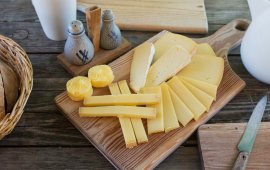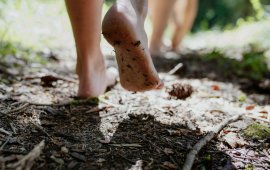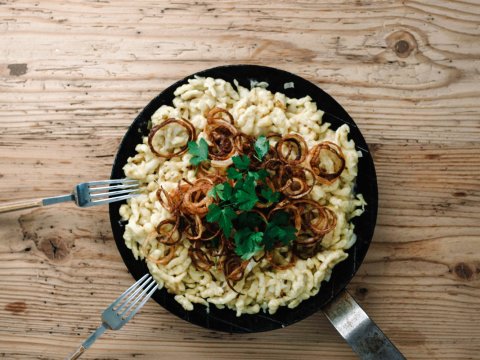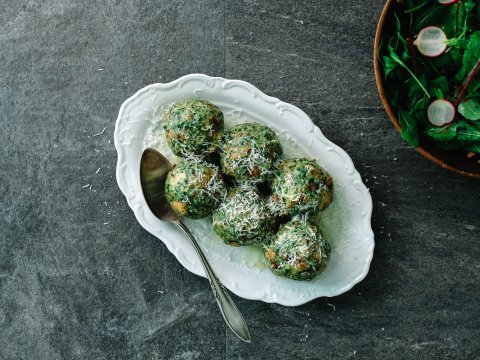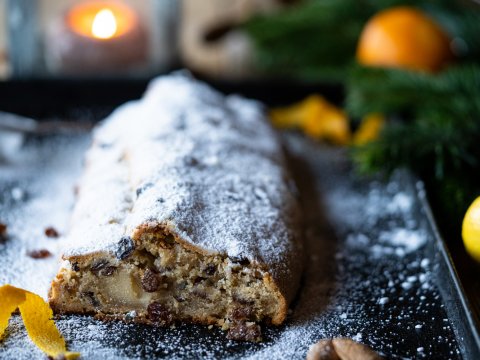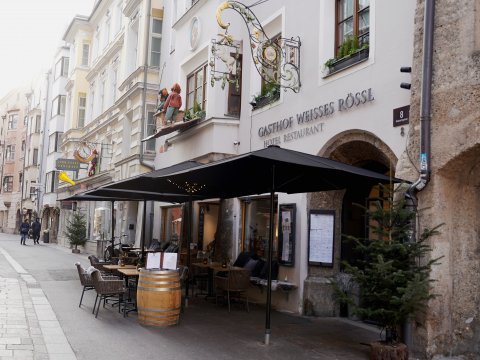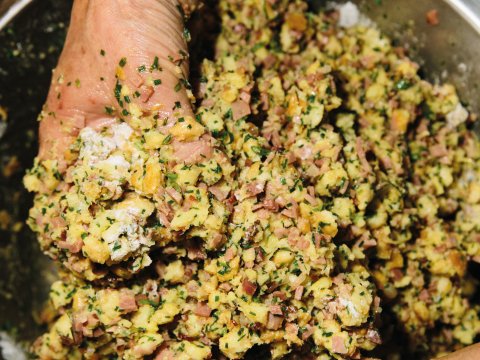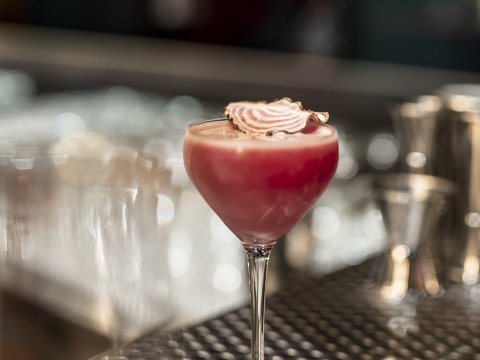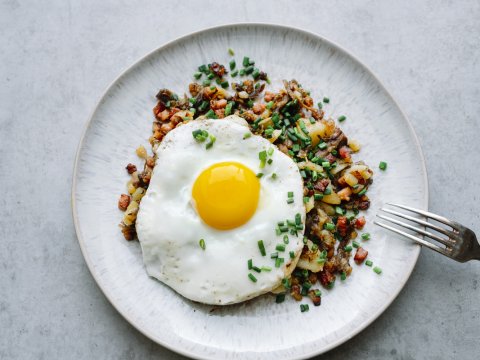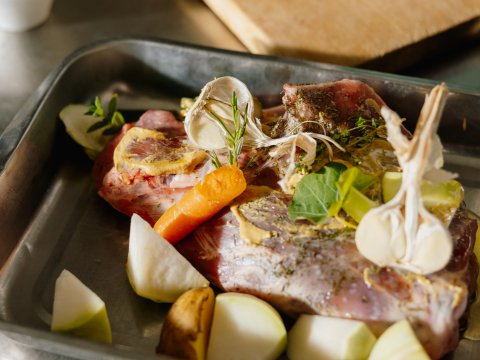Plant-Based Hiking in Tirol
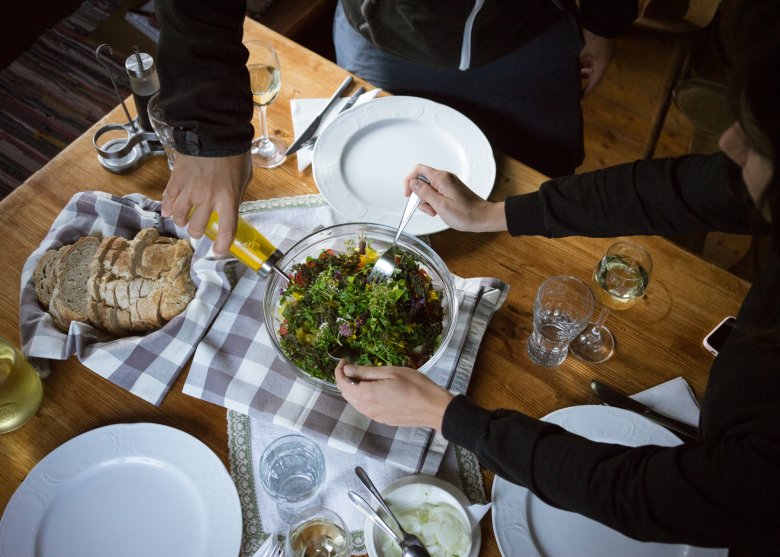
Oat milk cappucinos, raspberry-banana smoothies, sweet-and-sour poke bowls – in urban centres like Innsbruck, vegan food is pretty much everywhere. But what's it like in the mountains? Our vegan author reporter out for a little plant-based hiking. Joining her on a five-day walk in the Gschnitztal Valley was her boyfriend – not a vegan himself ("Sorry, it just tastes too good.") but most defintely a fan of organic produce.
For the perfect salad, Ingrid Schlögl needs one more thing: herbs. Up here in the mountains there is no need for a herb garden – herbs are everywhere you look. Ingrid bends down, takes a quick look and smiles. "Excellent. This is yarrow. It has lots of magnesium." Wild chives and lady's mantel are also on the menu, plus a little arnica. The latter is used to make a tonic, she explains as we arrive back at her hut and head into the kitchen.
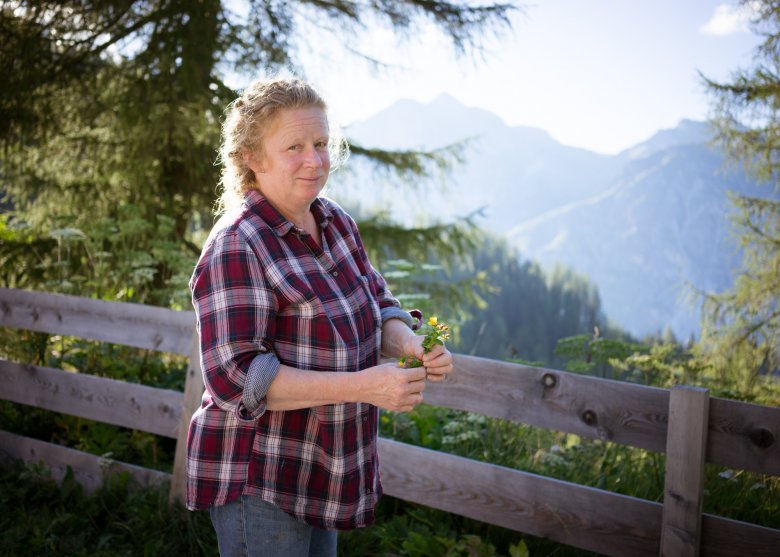
Ingrid runs the Trunahütte, a mountain hut at 1,750 metres above sea level. It takes around four hours to walk here from the nearest railway station in the village of Steinach am Brenner. Today the sun is out and the hut is full. Her nephew, David, normally helps out but has twisted his ankle, leaving Ingrid on her own. As the sun slowy disappears and the air turns cooler, it is finally time for a breather – until I arrive.
My boyfriend, Mick, and I are hungry from the long walk up to the hut and looking forward to eating. Cheese dumplings and 'Kaiserschmarrn', a thick pancake chopped into pieces and served with apple sauce, are perfect for Mick. "My dumplings are famous across the valley," says Ingrid, adding that they are more popular than the meat dishes on the menu. Talking of meat and meat-based products, I am (unsurprsingly) the more complicated one. Ingrid is very understanding of my veganism and offers to make me a salad with grated apple, wild herbs and homemade bread.
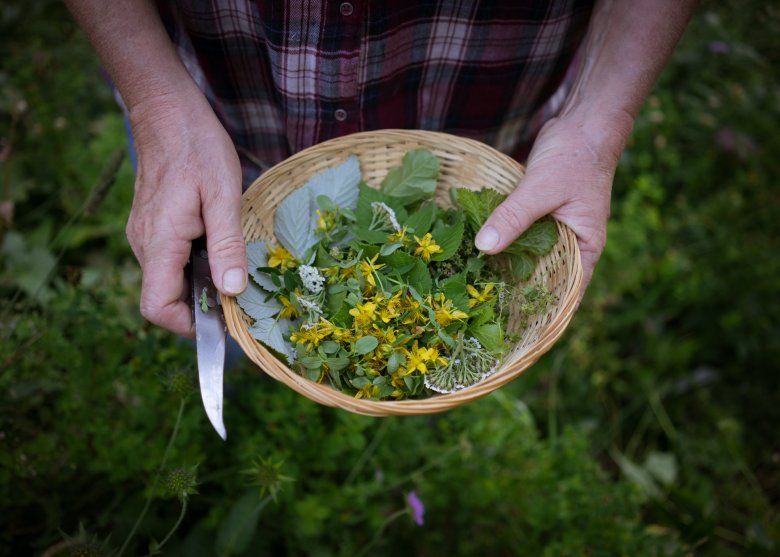
At the same time, there's not much chance of Ingrid going vegan herself any time soon. Vegetanarianism she could live with, she says, but when it comes to veganism there are just too many things she couldn't go without. "Eggs," she says. "Why wouldn't you want to eat them? After all, the hens would only end up eating them themselves."
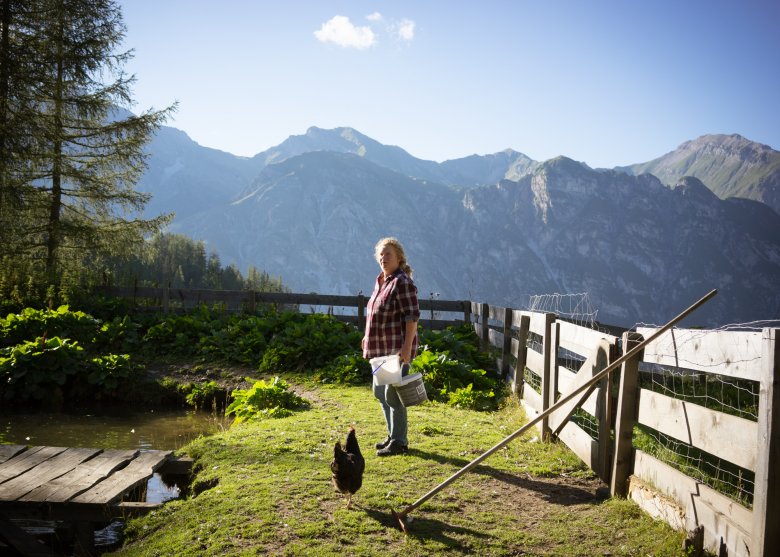
She's certainly not the only person I meet on my hike who is surprised by my choice to pursue a plant-based diet. Up here in the mountains there is still the idea that hearty foods like sausages and dumplings are what you need to get you through a long day of walking. That may be the case, but I am willing to try an alternative. Mick and I will be spending five days on the Gschnitztal Hut Hike. The route is a challenge: 5,650 vertical metres of uphill and downhill, with several long days out on the trails. I have already packed my rucksack full of vegan snacks – after all, there's nothing worse than hiking on an empty stomach. I have phoned ahead and spoken to the owners of the huts we will be staying at to let them know about my vegan diet. Let's see how things go.
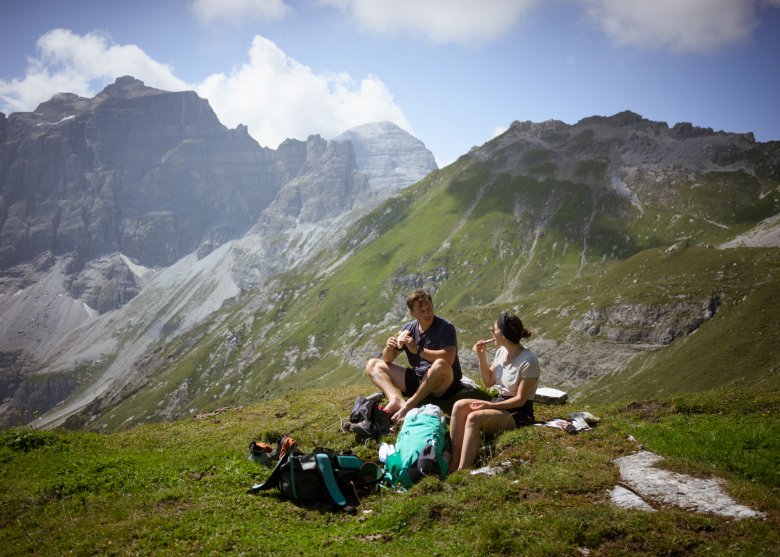
Vegan 'Kaiserschmarrn' at the Tribulaunhütte
The next morning we are greeted by a wonderful spread including coffee, Ingrid's homemade quince jam, vegetables and bread. We make ourselves a few sandwiches for lunch and head off towards the first challenge of the day, the Trunajoch ridge, which will eventually lead us to the Gschnitzer Tribulaunhütte. The first bit is easy, but after around two and half hours of hiking we find ourselves high in the mountains. This hike is rated black (difficult) and includes a few narrow and exposed sections such as this one. Time for a break! I rummage around in my rucksack and pull out a few soybean sausages, bread, dried bananas and an apple. I need a bit of protein after our sugar-rich breakfast.
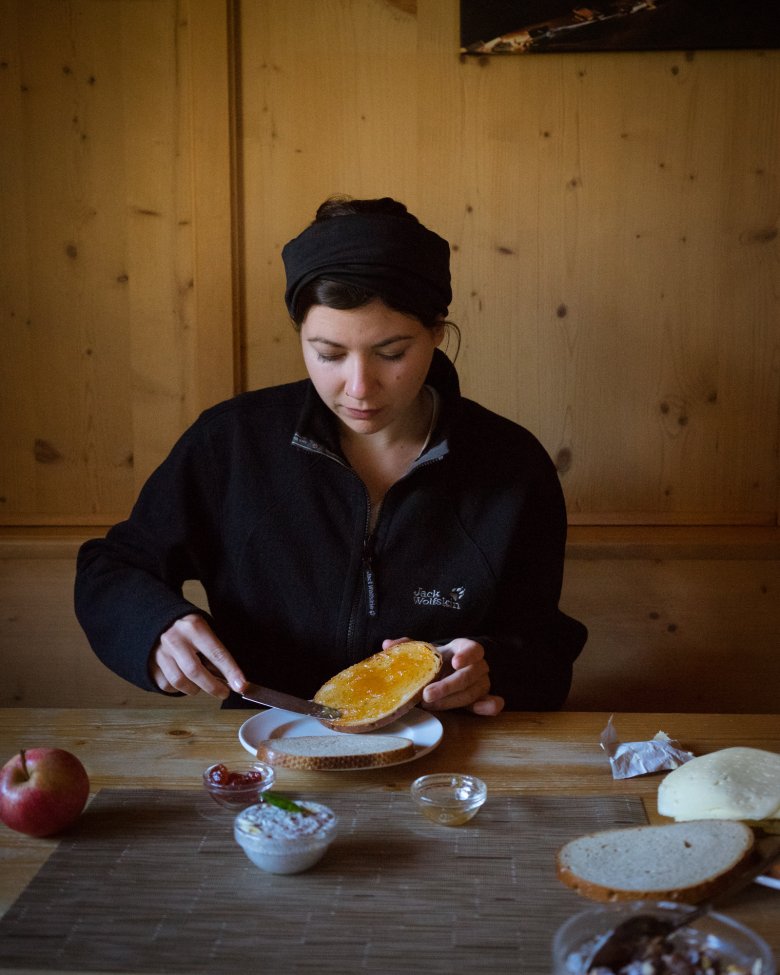
We soon reach the Gstreinjöchl ridge, with the Tribulaunhütte just visible between the rocks. It looks almost close enough to touch, but the hike up along the winding path seems to never end. When we finally get there we are both hungry again. Luckily the owner of the hut, Verena Salchner, has already prepared my lunch: roast potatoes and salad.
It turns out that the Tribulaunhütte is a family affair. Verena's father, Seppl, handed over the hut to his daughter in 2012, though he still helps out in the kitchen. Potatoes, onions, olive oil, salt, pepper and majoram are all mixed in a frying pan. Verena explains that they don't get many vegans up here at the Tribulaunhütte. Due to the hut's location high in the mountains and the related difficulties sourcing produce, they are unable to cater to every taste and dietary requirement – though, she adds, they are always willing to try. "We recently had a group from Sweden who wanted a vegan version of Kaiserschmarren," she says. Sounds like my kind of thing! I hadn't really expected anything quite as spectacular as that up here at 2,064 metres, but Verena disappears into the kitchen and soon returns carrying a 100% vegan version of this traditional sweet treat made using flour, mineral water and sugar. It may not have quite the same golden brown colour as the original (crammed full of milk and butter), but it tastes just as good.
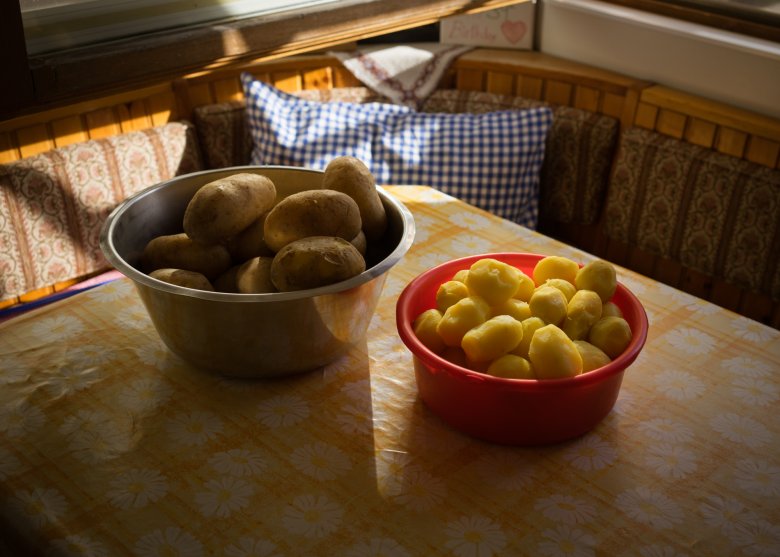
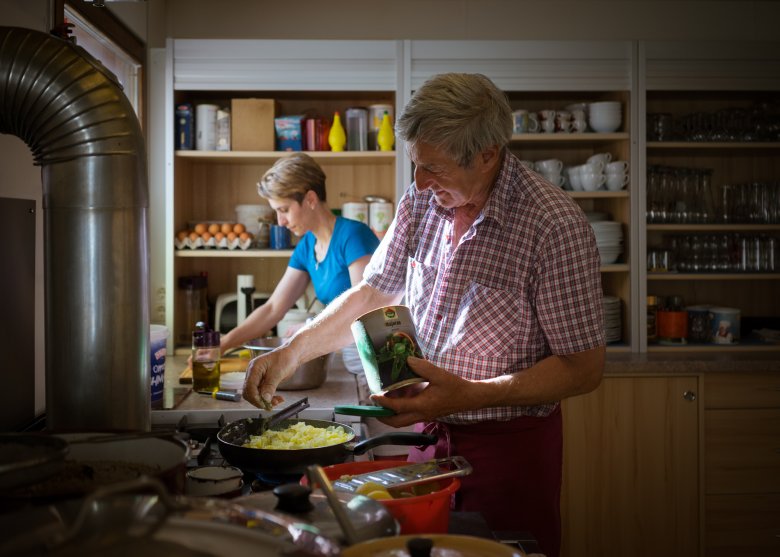
Breakfast is once again bread and jam. "Can you eat bread?" asks our host. I'd not really thought about it until now, to be honest, but it's true that some breads contain milk and butter.
She kindly offers to make me a loaf of sourdough bread from plant-based ingredients. Much of the butter and milk are replaced by lots of sugar, so I have plenty of energy for the first climb of the day up to the Sandesjöchl. The trail up to the ridge is rocky, but the views at the top are amazing. We continue to an area of marshland on the Kuhberg mountain, where a large rock invites us to sit down and take a break. After wolfing down a few vegan snacks, we continue on our route. The weather gods are not smiling on us today – we spend an hour walking through a thunderstorm complete with rain, wind and hail. You can imagine how relieved we are to finally make it to the Bremer Hütte with it hot showers and drying room. We are both incredibly hungry, so it's a good job the hut is more than prepared for my vegan requests.
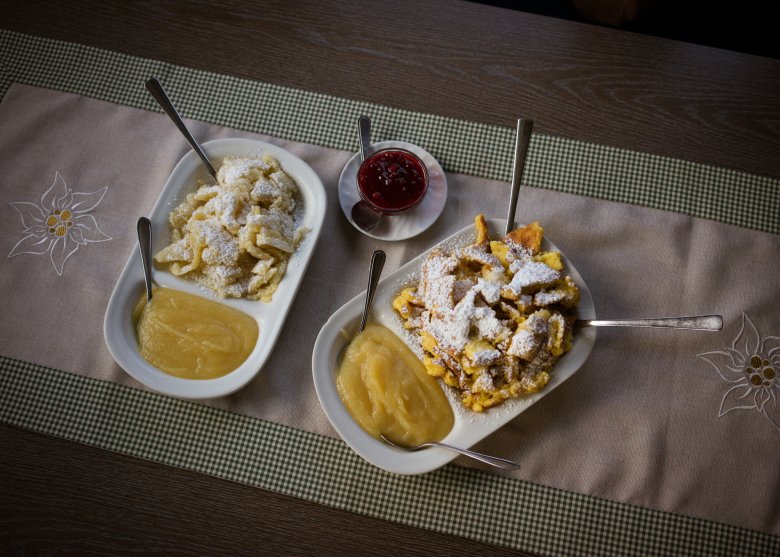
Three-course meal at the Bremer Hütte
Croatian head chef Zelko Toth knows is a bit of an expert when it comes to vegan food. The pumpkin-and-coconut-milk soup is ready and waiting as we arrive. Pumpkin also features in the main course, seasoned with salt, pepper, rosmary and curry powder, served with Rösti. Zelko turns up the heat and a flames leap out of the pan. Show cooking at over 2,000 metres above sea level! Katharina, his girlfriend and assistant chef in the kitchen, presents a vegan chocolate-and-zucchini cake enough to send gluten-free hipsters wild. It seems that vegan guests are quite common here at the hut, which is why the kitchen team are such experts at plant-based cooking.
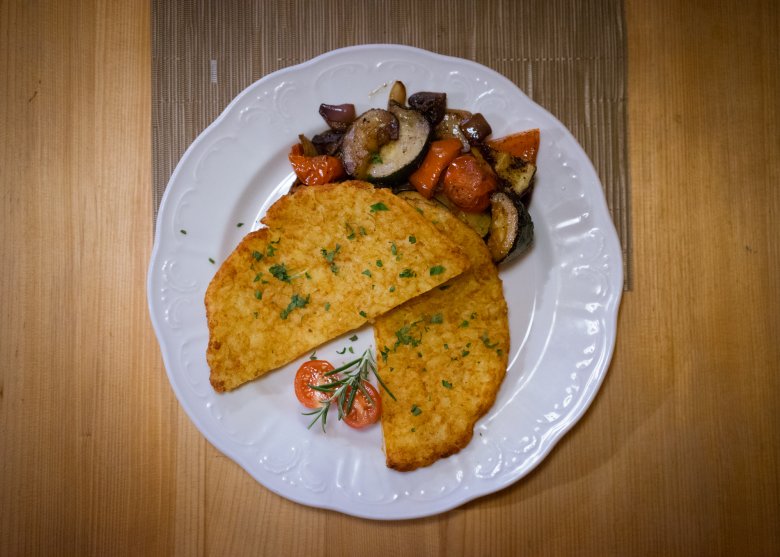
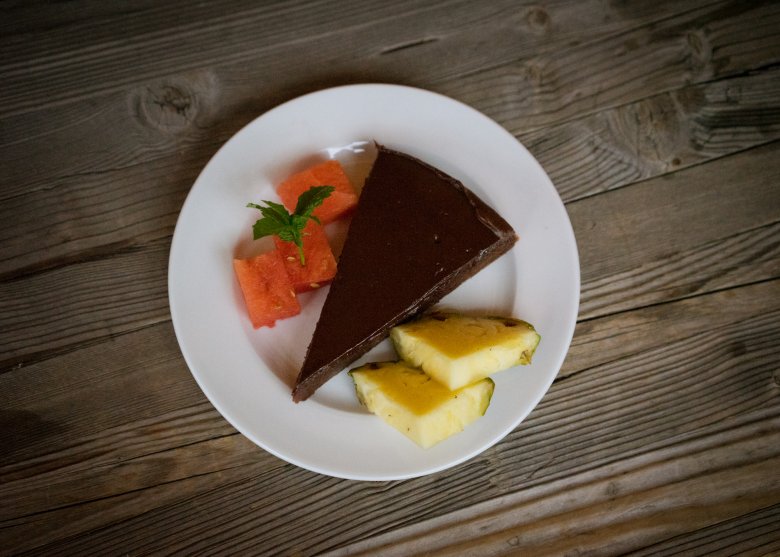
The dining room at the Bremer Hütte is heaving. On one table a group of hikers treat themselves to a well-earned schnapps. Over in the corner there is a mountain guide regaling his guests with tales of spectacular rescues in the region. And above it all I just about hear the cry of "vegan" as owner Christian Höllrigl tries to find out who has ordered the vegan variation. I seem to be the only vegan in the house tonight – even my boyfriend Mick opts for a hearty Wiener Schnitzel after our wet and wild day on the trails.
I feel like the odd one out with my 100% plant-based diet. The reality is, however, that until just a few decades ago meat was anything but common in the more remote areas of Tirol. The rural population lived mainly from cereals and dairy products. Each year the farmer would slaughter one pig and maybe one or two sheep. Calves and cows would only be killed if absolutely necessary. In 1588, the poet Georg Rösch wrote that a typical cellar in Tirol contained the following: "Peas, aparagus, artichokes; from the south: lemons, oranges, nuts; apples, cheese, fish, smoked meats." For breakfast there would often be a portion of "Koch", an early version of porridge.
The next morning we are greeted by much better weather. Before setting off we chat with Stefanie Höllrigl, who helps run the hut, and she advises us against taking the route via the Lauterer See lake to the Innsbrucker Hütte. After yesterday's heavy rain, she explains, the rocks will be very slippery. Terrain for experts only, she warns. I am no expert.
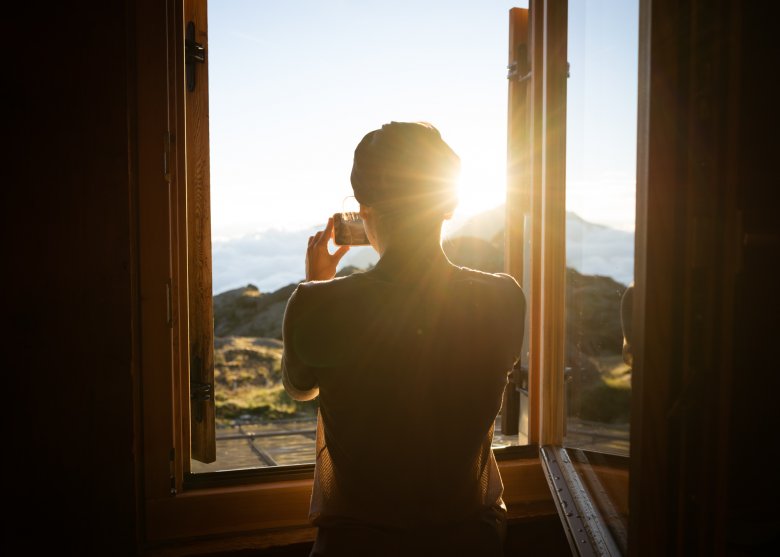
Sweet treats at the Innsbrucker Hütte
We decide to take the route via the Simmingsee lake, which involves first descending and then climbing back up. It includes a section of the Stubai High Trail, where some sections have ladders and a steel rope anchored to the rock for added safety. We make good progress, leaving us enough time for a quick break. A vegan energy bar with almost 300 calories is perfect fuel for the challenge ahead. I always make sure to have a bar in my bag, as well as dates and dried bananas. It may not look like much, but you would be surprised how filling they are. For protein I take mixed nuts and soybean sausages.
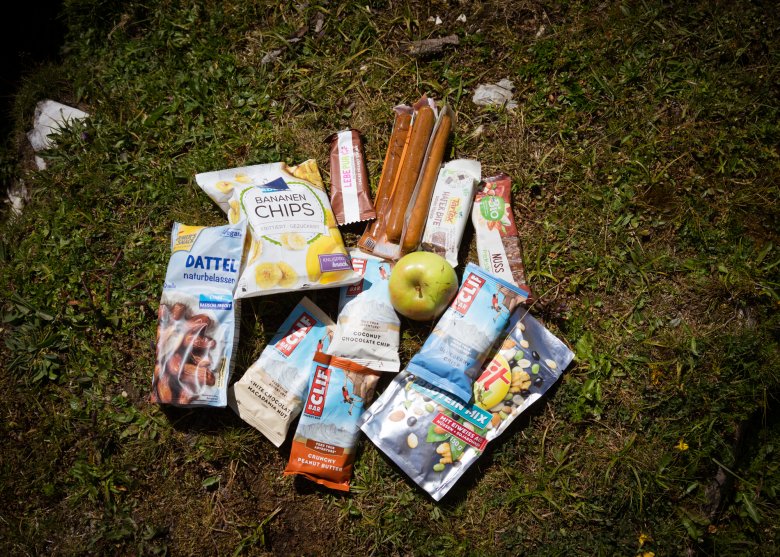
In the afternoon we reach the Innsbrucker Hütte at 2,369 metres above sea level. We manage to get a cosy spot by the open fire, next to the window looking out over the mountains. Young waitresses whizz past in colourful Dirndls, taking orders and bringing food. One of them, Sophia, helps me to put together a vegan meal. "Vegetable broth with chickpeas? How about peppers filled with rice?" In the end I go for the classic potatoes and salad.
The Innsbrucker Hütte doesn't get that many vegans, I am told. Maybe the odd vegetarian now and then. On the other hand, it seems that this trend is gaining ground among hikers as well. Sophia tells me that she recently had a group of ten walkers, all vegan, who enjoyed spaghetti with tomato sauce at the hut. There aren't always that many vegan items on the menu, Sophia adds, but where there's a will there's a way. I understand totally how tough it must be to cater to every wish and need up here in the mountains, where everything has to be delivered using a special cable car connecting the hut to the valley below. Today I can't find anything vegan on the dessert menu, so I have to make do with watching Mick wolf down his Kaiserschmarren – the third in three days – while I eat the apple sauce on the side. Feeling sorry for me, Sophia brings over a few sweet vegan treats she has managed to find.
Instead of the classic bread and jam for breakfast, this time we are treated to something different. Porridge (made with water instead of milk) with flakes of dark chocolate and sliced apple. Healthy, hearty and full of the energy we need for the day ahead. I wish I'd had the same idea earlier in the week. We feel ready to conquer the world as we leave the hut and set off towards the Padasterjochhaus.
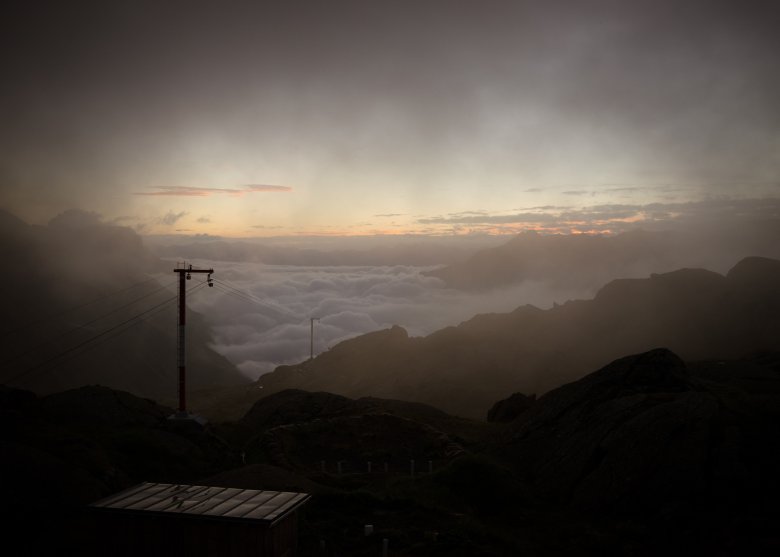
Padasterjochhaus: pea soup renaissance
Our fifth and final day is set to be the toughest of them all. The first 600 vertical metres are downhill into the Pinnistal Valley. The air is pleasantly cool and we make quick progress as we descend the winding trail. Down in the valley we soon see a sign branching off to the right. It will take us from the valley floor along the Jubiläumssteig trail to the Silbersattel ridge just below the peak of the Kirchdachspitze mountain. The terrain is stony, sandy and then rocky – a mix of switchback corners and exposed sections with steel ropes anchored into the rock for safety. We can't see the top of the mountain – the fog is too thick – but I suppose the advantage of being in the middle of the clouds is that you can't see down either! Two hours and 1,200 vertical metres of thigh-burning climbing later we finally reach the Silbersattel ridge. What a relief! Time for dinner.
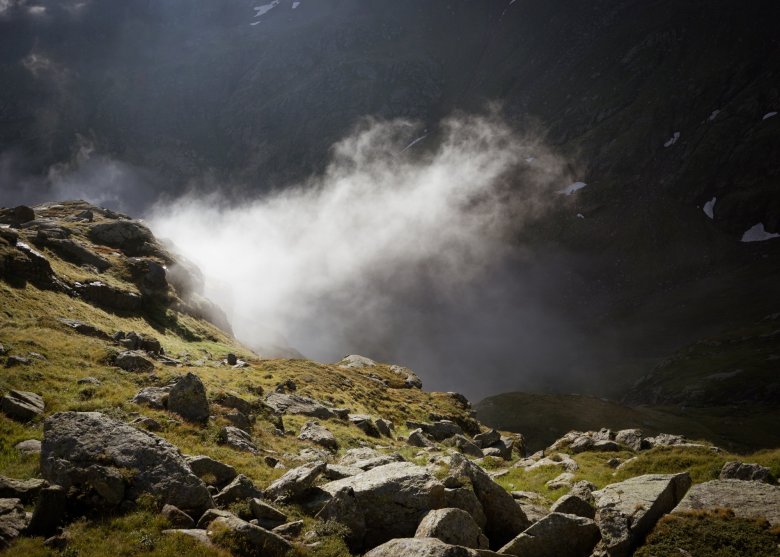
I reach into my rucksack, grab my final soybean sausage and quickly eat it together with a piece of bread. Shame we can't see anything – the view up here must be amazing. We descend via the Padasterjoch ridge back into the Gschnitztal Valley, where we reach the Padasterjochhaus at 2,232 metres above sea level. This hut dates back to 1907, when it was built with the help of donors from Vienna, Styria and Munich – and to this day there is a room named after each of these places. Our host, Agi Pranger, shows me around and tells me about the history of the hut.
I am introduced to husband Paul. "Made it over the ridge? Respect! Many people turn around and head back down into the Pinnistal Valley," he adds, before clambering into his car and setting off down a rocky road "to go and get your vegan stuff." When he returns, the ingredients are transformed by Agi into a traditional pea soup. This used to be one of the absolute classics on the menu of each hut in Tirol, but in recent years it has become more of a rarity. Now, with the increase in vegetarians and vegans, it seems that the soup (made using peas, broth and vegetables) is enjoying somewhat of a renaissance.
The soup is followed by polenta with vegetables and a fruit salad. Mick, a creature of habit if ever there was one, opts for dumplings followed by a hearty portion of (surprise, surprise) Kaiserschmarren. There are just a few of us at the hut, so we all sit down together and soon find ourselves deep in conversation. Christian from Augsburg decides to order what I'm having – and sends a photo to his daughter of him and his vegan dinner.
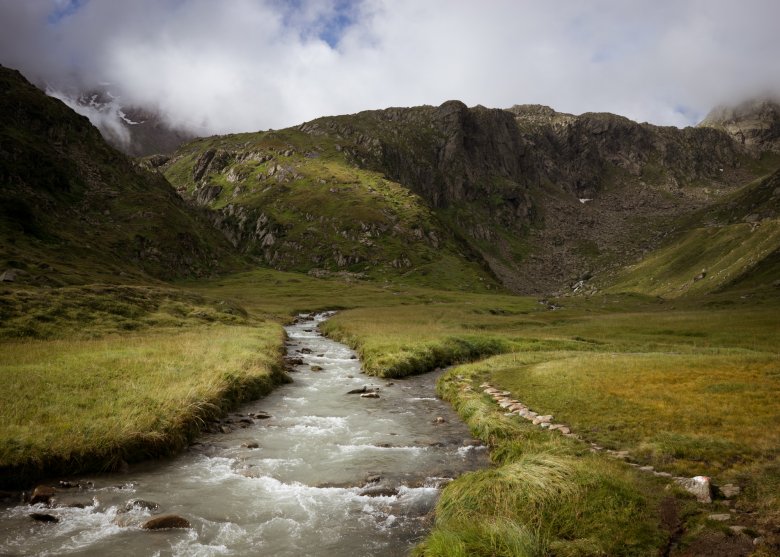
Our final day is sunny and clear. We briefly think about climbing one of the nearby mountains, but my feet are tired from the week's walking. We decide to head straight down into the valley, along the banks of the rushing Gschnitzbach stream all the way to the railway station in Steinach am Brenner. Two and a half hours later we are once again in the world of chai lattés, smoothies and poke bowls – back in civilisation.
I miss the rythmn of the mountains: waking up early, heading out onto the trails and enjoying the wonderful views. It is not until now, back down in the valley, that I notice how tired I am. Every muscle in my body is aching. Then again, I suppose I have just hiked 56 kilometres in the mountains. I have lost a few kilos en route (looks like I couldn't quite replace all the calories I burned each day), but I never went hungry. Now it's time for a big bowl of porridge and an oat milk cappuccino – feels a bit like being back in the Gschnitztal Valley!
Three tips for hikers on a plant-based diet
- Be prepared. When booking your stay at the hut, tell them you are vegan. Everyone is very understanding.
- Pack snacks. You never know when you might get hungry – especially if there are unexpected food problems at the hut.
- Make sure you get enough fat and protein. Energy bars. nuts and soyabean sausages are hearty and will keep you full for a while.










